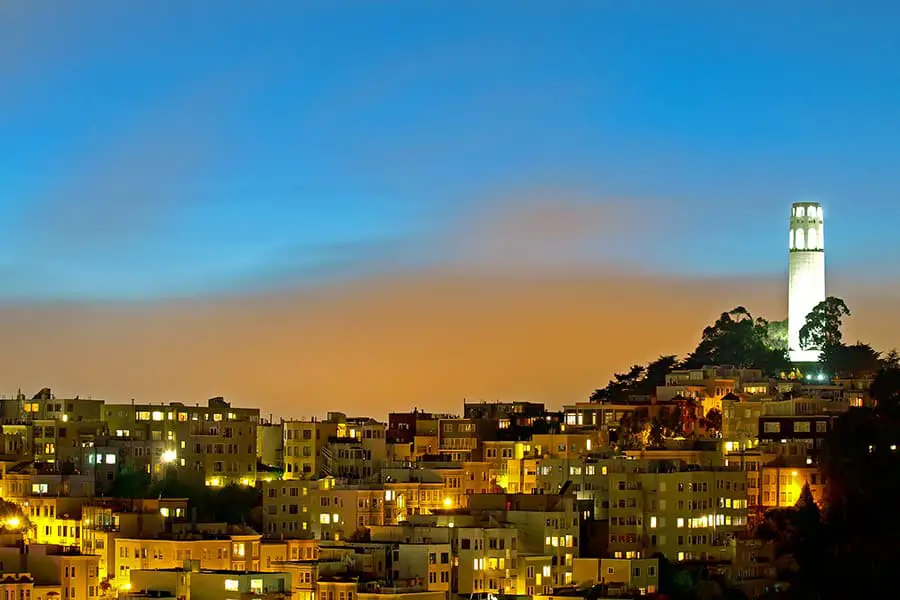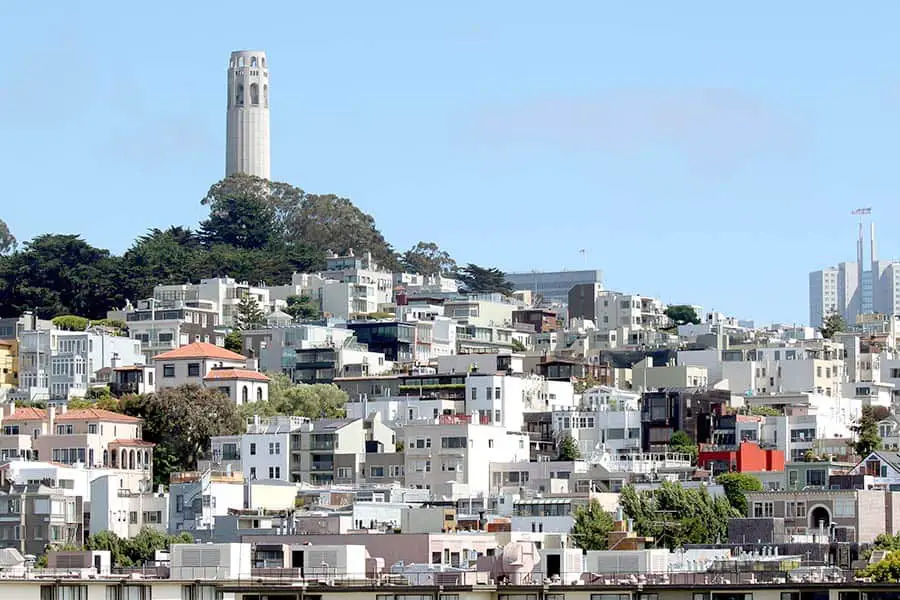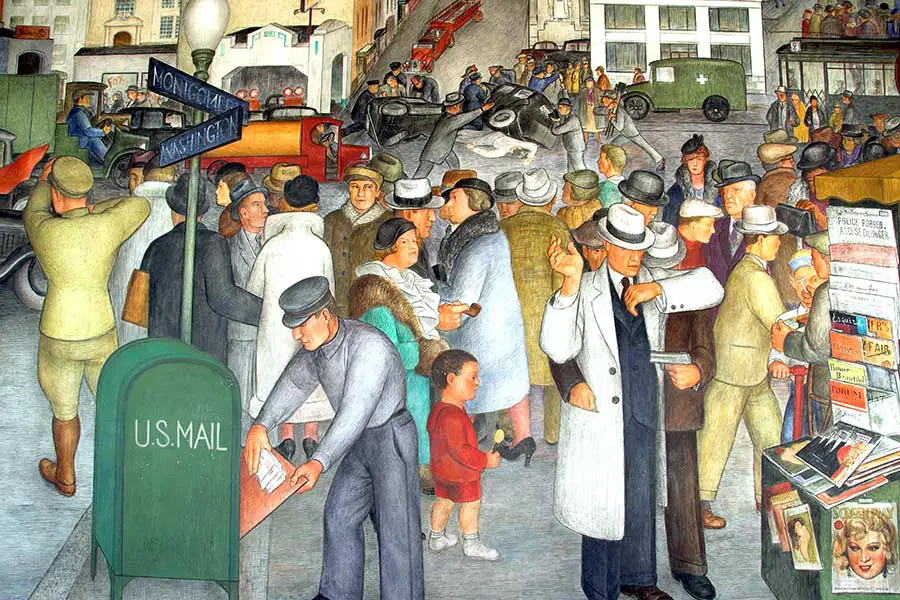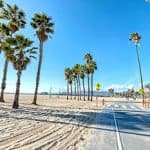
Throughout the City of San Francisco, there are dozens of points of interest and historic landmarks. One of the most beloved by local residents is the famous Coit Tower. This unique structure has been a part of the city’s history for nearly 100 years. So, what exactly is the purpose of the Coit Tower?
The Coit Tower serves as a memorial to the heroic firefighters who saved the City of San Francisco from destruction during several major fires. The tower has an observation deck that provides sweeping views of the city. It’s an extremely popular tourist attraction that gets thousands of visitors each year.
When visiting the Bay Area, you won’t want to miss this classic landmark. In this post, we’ll cover the history of the tower, the amazing artwork that lies inside, what visitors can expect to see, and how to get there.
Coit Tower – Why Was it Constructed
Coit Tower (pronounced COYT) is a 210-foot tall art-deco style tower located in the Telegraph Hill neighborhood of San Francisco. Officially known as the Coit Memorial Tower, the tower serves as a monument to honor the many firefighters who risked their lives to protect the City of San Francisco from the five major fires that nearly destroyed the city.
The tower was built utilizing funds donated by a local benefactor who spent most of her life supporting the city’s brave firefighters — Lillie Hitchcock Coit.
Today, the tower serves as a favorite tourist attraction, observation point, and an important art display dating back to the 1930s, during the midst of the Great Depression. The ground floor of the tower has a rotunda that contains a series of murals painted by various local artists depicting life in California during the time when the works of art were completed.
In 1984, the tower was listed as a San Francisco Designated Landmark. It was later added to the National Register of Historic Places in January of 2008.
Can You Go to the Top of Coit Tower?

The location of the tower had long been used as an observation point. There was originally a 2-story observation deck constructed in 1849 to monitor ships coming in and out of the bay and broadcasting messages to city residents about their arrivals.
Visitors can ride an elevator to the observation deck atop of Coit Tower for an opportunity to take in the panoramic views, including of the Golden Gate Bridge, the island Alcatraz, the Transamerica Pyramid, Fisherman’s Wharf, the Bay Bridge, and the famous Lombard Street. Tickets for the elevator can be purchased in the gift shop.
Who was the Coit Tower Named After?
The tower was named in honor of Lillie Hitchcock Coit (1843-1929), the heiress to a wealthy San Francisco family. Growing up, she was a strange character who loved to smoke, gamble, and wear men’s pants (well before it was considered appropriate for a lady to do so).
As a teenager, Lille became fascinated with the workings of the local fire departments. At that time, there wasn’t one city-organized fire department. Instead, a group of volunteers independently operated each brigade. This setup was problematic since a fire could quickly spread and destroy part of the city, which it did on several occasions.
One day as she was on her way home from school, Lillie spotted the Knickerbocker Engine Co. No. 5 on its way up Telegraph Hill to respond to the fire. They were short-staffed, so Lille decided to pitch in and help.
Due to her heroic actions, she quickly became recognized as a patroness for the local fire departments. She would frequently be seen riding on the fire engines on the way to a fire or local parade.
When Coit passed away in 1929, she requested that a third of her estate be left to the City of San Francisco to beautify the city that she loved. The city used this money to build Coit Tower, and it was named in her honor.

The tower cost about $118,000 (around $1.8 million today). The rest of the money was used to build a statue of three firefighters, one of whom can be seen carrying a woman in his arms, in Washington Square Park.
Other Posts of Interest
- What Is John Muir Known For?
- Where Does The San Francisco Symphony Play?
- Is Ghirardelli Chocolate Made in San Francisco?
- Do You Need A Car To Live In San Francisco?
Construction of the Coit Tower
The Coit Tower was constructed between 1932 and 1933, and the design came from architects Arthur Brown, Jr. and Henry Howard. The tower was built using unpainted, reinforced concrete.
The structure consists of three nested cylinders. The inner cylinder contains a shaft for the elevator that takes guests to the observation deck. The middle cylinder is a stairwell that wraps up the tower to the top. Finally, the outer cylinder forms the outer wall and also supports the observation deck.
The tower’s original design contained plans for a restaurant, but that was eliminated and instead was changed to an exhibition area that now includes the famous Coit Tower murals.
Bay Area Answers Fun Fact: Coit Tower is the most extensive collection of Public Works Art Project art in the country.
Planning Your Visit to Coit Tower
Visitors won’t want to miss this significant San Francisco landmark, so it’s important to plan your visit and take note of some essential details.
First, parking can be difficult at Coit Tower. A parking lot is free to the public, but it is small and fills up quickly. Parking structures in the area are expensive and will require a short walk (mostly uphill). The best option is to take public transportation. The #39 Coit Tower bus will take you directly to Pioneer Park, where the tower stands.
The tower is only open during the daytime from 10 AM to 5 PM (extended hours are available from May to October when the tower stays open until 6 PM). While you can’t go up in the tower at night, it is illuminated, which makes for great evening photos.
You should be sure to wear comfortable footwear as visitors will need to climb approximately 500 steps just to reach the base of the tower. One important thing to note is that the elevator to the observation deck is not wheelchair accessible.
Dogs are not allowed inside the Coit Tower. However, they are welcome in Pioneer Park as long as they are kept on a leash.
The cost to enter the Coit Tower is $10 for adults and $7 for kids (discounts are available for local residents, seniors, and children under 12).
Who Painted the Murals in Coit Tower?

The murals inside the ground floor rotunda of the Coit Tower were painted by about 25 local artists (not including assistants). Many of these painters came from the California School of Fine Arts. The murals are painted in the American social realism style.
There are 37 murals in total that cover 3,961 square feet. Each painter was assigned sections based on their notoriety. Popular artists were given large areas to paint, while lesser-known artists were assigned small sections.
The Coit Tower murals were paid for by the Public Works of Art Project, the first of the New Deal’s federal programs for artists. The various artists agreed on a common theme to depict different aspects of California life at the time.
The murals quickly sparked controversy. Many of the murals feature undertones of racial equality, leftist political ideas, and Marxism. For example, in one of the murals titled the Library, you can see one of the subjects reaching for a copy of Karl Marx’s Das Kapital.
Many viewed this to be communist propaganda. At the very least, it’s a great opportunity to step back in time to get the feeling and tension of the political landscape. After governmental pressure, some parts of the murals were changed, such as removing a hammer and sickle symbol and the words “Western Worker.”
Does the Coit Tower Contain Petrified Wood?
There is a rumor that the Coit Tower was constructed using petrified wood. Coit Tower does not contain petrified wood. This is a myth that was started by an American science fiction series called Warehouse 13. One episode claims that Coit Tower was built from petrified wood in honor of firefighters since petrified wood can’t be burned. In the show, a supernatural character needed petrified wood to become immortal.
Take in the City from Coit Tower
Few vantage points in the city can compete with Coit Tower. The best part is that it’s easily accessible from other popular tourist destinations such as Union Square, historic Chinatown, and Fisherman’s Wharf. Besides the fantastic views, the Coit Tower is an engineering marvel that is uniquely San Franciscan.





